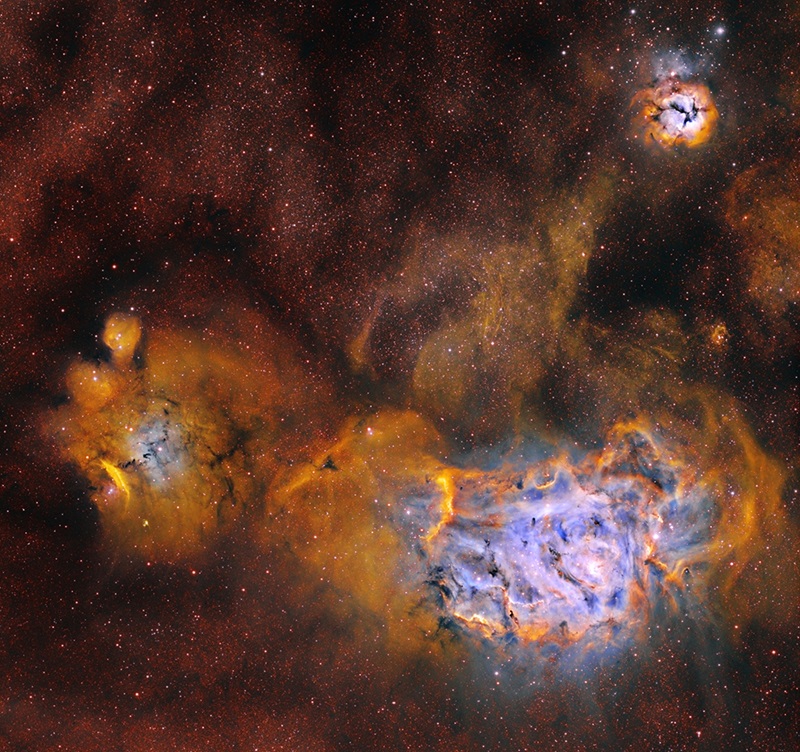Blog
X-ray & Radio Images of Cygnus OB2
Stars come in different sizes and masses. Our Sun is an average-sized star that will have a lifespan of some 10 billion years. More massive stars, like those found in Cygnus OB2, only last a few million years. During their lifetimes, they blast large amounts of high-energy winds into their surroundings. These violent winds can collide or produce shocks in the gas and dust around the stars, depositing large amounts of energy that produce X-ray emission that Chandra can detect. In this composite image of Cygnus OB2, X-rays from Chandra (red diffuse emission and blue point sources) are shown with optical data from the Isaac Newton Telescope (diffuse emission in light blue) and infrared data from the Spitzer Space Telescope (orange).
The region is approximately 1,400 parsecs from Earth in the constellation of Cygnus. The young cluster is one of the largest known and the largest in the northern hemisphere with some authors formerly classifying it as a young globular cluster similar to those in the Large Magellanic Cloud.

Eric J. Gale (September 20, 1938 – May 25, 1994) was an American jazz and session guitarist.
Born in Brooklyn, New York, Gale began playing guitar at the age of 12. Although he majored in chemistry at Niagara University, Gale was determined to pursue a musical career, and began contributing to accompaniments for such stars as Maxine Brown, the Drifters, and Jesse Belvin. He soon began to attract the attention of King Curtis and Jimmy Smith, who began recommending him for studio work. He became known first as a session musician in the 1960s, eventually appearing on an estimated 500 albums. Among the many artists he recorded with were Mose Allison, Aretha Franklin, Bob James, Paul Simon (Gale plays a supporting role in the 1980 film One-Trick Pony, written by and starring Simon), Lena Horne, Quincy Jones, Bob Marley, Nina Simone, Peter Tosh, Grover Washington, Jr., Herbie Mann, Esther Phillips, Joe Cocker, Carly Simon, Van Morrison, Al Jarreau, Dave Grusin, Lee “Scratch” Perry, Paul Douglas and Billy Joel. He also had played in Aretha Franklin’s stage band. Gale died of lung cancer in May 1994 at the age of 55.
more...Edwin Joseph Bocage (September 20, 1930 – March 18, 2009), known as Eddie Bo, was an American singer and pianist from New Orleans. Schooled in jazz, he was known for his blues, soul and funk recordings, compositions, productions and arrangements. He debuted on Ace Records in 1955 and released more single records than anyone else in New Orleans other than Fats Domino.
Eddie Bo worked and recorded for more than 40 different record labels, including Ace, Apollo Records, Arrow, At Last, Blue-Jay, Bo-Sound, Checker, Chess, Cinderella, Nola, Ric (for which business his carpentry skills were used to build a studio), Scram, Seven B, and Swan. He is described at Allmusic as “a sorely underappreciated veteran of the New Orleans R&B scene.”
Eddie Bo grew up in Algiers, Louisiana and in the Ninth Ward of New Orleans. He came from a long line of ship builders with the male members of his family being bricklayers, carpenters and masons by day and musicians by night. Eddie’s mother was a self-taught pianist in the style of friend, Professor Longhair. The Bocage family was involved in the traditional jazz community with cousins Charles, Henry and Peter, who played with Sidney Bechet, contributing to jazz orchestras before World War II.
more...Billy Bang (September 20, 1947 – April 11, 2011), born William Vincent Walker, was an American free jazz violinist and composer. Bang’s family moved to New York City’s Bronx neighborhood while he was still an infant, and as a child he attended a special school for musicians in nearby Harlem. At that school, students were assigned instruments based on their physical size. Bang was fairly small, so he received a violin instead of either of his first choices, the saxophone or the drums. It was around this time that he acquired the nickname of “Billy Bang”, derived from a popular cartoon character.
Bang studied the violin until he earned a hardship scholarship to the Stockbridge School in Stockbridge, Massachusetts, at which point he abandoned the instrument because the school did not have a music program. He had difficulty adjusting to life at the school, where he encountered racism and developed confusion about his identity, which he later blamed for his onset of schizophrenia. Bang felt that he had little in common with the largely privileged children at the school, who included Jackie Robinson, Jr. (son of baseball star Jackie Robinson) and Arlo Guthrie, and he struggled to reconcile the disparity between the wealth of the school and the poverty of his home in New York. He left the school after two years and attended a school in the Bronx. He did not graduate, decided not to return to school after receiving his draft papers, and at the age of 18, he was drafted into the United States Army
more...Keith Moore “Red” Mitchell (September 20, 1927 – November 8, 1992), was an American jazz double-bassist, composer, lyricist, and poet. Mitchell was born on September 20, 1927, in New York City. His younger brother, Whitey Mitchell, also became a jazz bassist.
Mitchell was raised in New Jersey by a father who was an engineer and loved music, and a mother who loved poetry. His first instruments were piano, alto saxophone, and clarinet. Although Cornell University awarded him an engineering scholarship, by 1947 he was in the US Army playing bass. The next year he was in a jazz trio in New York City.
Mitchell performed and/or recorded with Mundell Lowe, Chubby Jackson, Charlie Ventura, Woody Herman, Red Norvo, Gerry Mulligan, and, after joining the West Coast jazz scene in the early 1950s, with André Previn, Shelly Manne, Hampton Hawes, Billie Holiday, Stan Seltzer, Ornette Coleman, and others such as Mahalia Jackson. He also worked as a bassist in the TV and film studios around Los Angeles, occasionally appearing on screen. Mitchell also appeared in documentaries about Tal Farlow and Zoot Sims.
https://www.youtube.com/watch?v=yxhF-8U7PsU
more...Elvira “Vi” Redd (born September 20, 1928) is an American jazz alto saxophone player, vocalist and educator. She has been active since the early 1950s and is known primarily for playing in the bebop, hard bop and post-bop styles. She is highly regarded as an accomplished veteran who has performed with Count Basie, Rahsaan Roland Kirk, Linda Hopkins, Marian McPartland and Dizzy Gillespie.
Redd is the daughter of New Orleans jazz drummer and Clef Club co-founder Alton Redd and Mattie Redd (née Thomas). She was born in Los Angeles. She was deeply influenced during her formative years by her father, who was one of the leading figures on the Central Avenue jazz scene. Another important musical mentor was her paternal great aunt Alma Hightower.
more...https://www.youtube.com/watch?v=vZVuXBZaZGs
more...David Bromberg (born September 19, 1945) is an American multi-instrumentalist, singer, and songwriter. An eclectic artist, Bromberg plays bluegrass, blues, folk, jazz, country and western, and rock and roll. He is known for his quirky, humorous lyrics, and the ability to play rhythm and lead guitar at the same time.
Bromberg has played with many famous musicians, including Jerry Jeff Walker, Willie Nelson, Jorma Kaukonen, Jerry Garcia, Rusty Evans (The Deep) and Bob Dylan. He co-wrote the song “The Holdup” with former Beatle George Harrison, who played on Bromberg’s self-titled 1972 album. In 2008, he was nominated for a Grammy Award.[3] Bromberg is known for his fingerpicking style that he learned from Reverend Gary Davis. Bromberg was born to a Jewish family in Philadelphia and raised in Tarrytown, New York. He attended Columbia College of Columbia University in the 1960s, studying guitar with Reverend Gary Davis during that period.
Proficient on fiddle, many styles of acoustic and electric guitar, pedal steel guitar and dobro, Bromberg began releasing albums of his own in the early 1970s on Columbia Records. His seven-minute rendition of “Mr. Bojangles” from 1972’s Demon in Disguise, interspersed with tales about traveling with song author Jerry Jeff Walker, earned Bromberg progressive rock radio airplay. In 1973, he played mandolin, dobro, and electric guitar on Jonathan Edwards‘ album Have a Good Time for Me.
more...Cass Elliot (born Ellen Naomi Cohen; September 19, 1941 – July 29, 1974), also known as Mama Cass, was an American singer and actress who is best known for having been a member of the Mamas and the Papas. After the group broke up, she released five solo albums. In 1998, she was posthumously inducted into the Rock and Roll Hall of Fame for her work with the Mamas and the Papas.
Ellen Naomi Cohen was born in Baltimore, Maryland, on September 19, 1941, the daughter of Bess (née Levine; 1915–1994) and Philip Cohen (died 1962).[2] All four of her grandparents were Russian Jewish immigrants. Her family was subject to significant financial stresses and uncertainties during her childhood years. Her father, involved in several business ventures throughout his life, ultimately succeeded through the development of a lunch wagon business in Baltimore which provided meals to construction workers. Her mother was a trained nurse. Elliot had a brother, Joseph, and a younger sister, Leah, who also became a singer and recording artist. Elliot’s early life was spent with her family in Alexandria, Virginia, before the family moved to Baltimore when Elliot was 15, and where they had briefly lived at the time of Elliot’s birth. Elliot, age 32, died in her sleep at the London flat where she was staying. According to forensic pathologist Keith Simpson, who conducted her autopsy, her death was due to heart failure. A drug screen that was part of the forensic autopsy revealed there were no drugs in her system. Elliot died in Flat 12, 9 Curzon Place (later Curzon Square), Shepherd Market, Mayfair, London, which was on loan from singer-songwriter Harry Nilsson. Four years later, The Who‘s drummer Keith Moon died in the same room, also aged 32 years.
Elliot’s body was cremated at the Hollywood Forever Cemetery in Los Angeles, California.
more...Muhal Richard Abrams (born Richard Lewis Abrams; September 19, 1930 – October 29, 2017) was an American educator, administrator, composer, arranger, clarinetist, cellist, and jazz pianist in the free jazz medium. He recorded and toured the United States, Canada and Europe with his orchestra, sextet, quartet, duo and as a solo pianist. His musical affiliations constitute a “who’s who” of the jazz world, including Max Roach, Dexter Gordon, Eddie “Lockjaw” Davis, Art Farmer, Sonny Stitt, Anthony Braxton, and The Art Ensemble of Chicago.
Abrams’s mother, Edna, was born in Memphis.His father, Milton, was born in Alabama and moved with his parents to Chicago. Richard Lewis Abrams was born there, the second of nine children, on September 19, 1930. His father became a self-employed handyman; his mother was a housewife. “Abrams’s paternal grandfather was ‘what you call a junk man’, selling the fruits of neighborhood foraging. Abrams and his brother would pull the cart around the neighborhood, eventually arriving at a junk-yard on State Street, where the items would be sold.” Abrams first attended Forrestville public school in Chicago. He grew up in a gang area; truancy and fighting meant that he was sent to Moseley School, a reformatory school for boys. There, in addition to strict discipline, he was taught about black histories. He later moved on to DuSable High School. Although he was aware of the strong music program there, led by Walter Dyett, Abrams preferred playing sports, so did not participate in Dyett’s classes. Among the future musicians Abrams met at the school were Charles Davis, Richard Davis, John Gilmore, Johnny Griffin, Laurdine Patrick, and Julian Priester.
more...The Lagoon Nebula (M8, bottom) and the Trifid Nebula (M20, upper right) are famous deep-sky objects in the constellation Sagittarius the Archer. This image was created by combining exposures through Hydrogen-alpha, Oxygen-III, and Sulfur-II filters.

George Lowen Coxhill (19 September 1932 – 10 July 2012), generally known as Lol Coxhill, was an English free improvising saxophonist and raconteur. He played the soprano or sopranino saxophone.
Coxhill was born to George Compton Coxhill and Mabel Margaret Coxhill (née Motton) at Portsmouth, Hampshire, UK. He grew up in Aylesbury, Buckinghamshire, and bought his first saxophone in 1947. After national service he became a busy semi-professional musician, touring US airbases with Denzil Bailey’s Afro-Cubists and the Graham Fleming Combo. In the 1960s he played with visiting American blues, soul and jazz musicians including Rufus Thomas, Mose Allison, Otis Spann, and Champion Jack Dupree. He also developed his practice of playing unaccompanied solo saxophone, often busking in informal performance situations. Other than his solo playing, he performed mostly as a sideman or as an equal collaborator, rather than a conventional leader – there was no regular Lol Coxhill Trio or Quartet as would normally be expected of a saxophonist. Instead he had many intermittent but long-lasting collaborations with like-minded musicians.
more...Cora “Lovie” Austin (September 19, 1887 – July 8, 1972) was an American Chicago bandleader, session musician, composer, singer, and arranger during the 1920s classic blues era. She and Lil Hardin Armstrong are often ranked as two of the best female jazz blues piano players of the period.
She was born Cora Taylor in Chattanooga, Tennessee. Lovie grew up with eight brothers and sisters. She took the name Cora Calhoun in her teens from an early marriage; she was married for a short time to a movie house operator in Detroit and then later married a vaudeville performer, Phillip Austin. She studied music theory at Roger Williams University in Nashville, and Knoxville College in Knoxville, Tennessee which was uncommon for African American woman and jazz musicians alike during the time.
In 1923, Lovie Austin decided to make Chicago her home, and she lived and worked there for the rest of her life. She was often seen racing around town in her Stutz Bearcat with leopard skin upholstery, dressed to the teeth. Her early career was in vaudeville, where she played piano and performed in variety acts. Accompanying blues singers was Lovie’s specialty, and can be heard on recordings by Ma Rainey (“Moonshine Blues), Ida Cox (“Wild Women Don’t Have the Blues“), Ethel Waters (“Craving Blues”), and Alberta Hunter (“Sad ‘n’ Lonely Blues”).
more...https://www.youtube.com/watch?v=4ySHLafN9Bw
more...More Posts
- Roy Ayers Day
- Prince Lasha Day
- World Music with Chapey Kong Nay
- Daily Roots with Barrington Spence
- The Cosmos with M1
- Otis Redding Day
- Elvin Jones Day
- World Music with Badie Mohd Al Tayeb
- Daily Roots with Torch
- The Cosmos with RCW 120
- Butch Warren Day
- James Clay Day
- Wilbur Ware Day
- World Music with Tsedenia Gebremarkos
- Daily Roots with the Impact All Stars
- The Cosmos with NGC 2080
- Buddy Holly Day
- Little Milton Day
- Sonny Rollins Day
- World Music with Paco de Lucia
